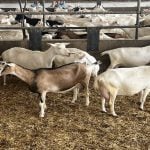BANFF, Alta. – The Alberta government hopes its new legislation
governing intensive livestock expansion will smooth the bumpy road of
controversy that the $5 billion a year industry has traveled in the
last five years.
“We think the industry is well poised to continue to expand,” said
Brian Rhiness, assistant deputy minister of agriculture in charge of
livestock.
“That expansion will not happen at any cost,” he told the Banff Pork
seminar.
The province finishes nearly 75 percent of the beef in Canada and 30
Read Also

Lending policy still focused on primary producers: Farm Credit Canada
Farm Credit Canada said it has not changed its business practices and remains committed to supporting all producers, after a report from an Ottawa-based media outlet claimed otherwise.
percent of the hogs. There is potential for further growth, but all
expansions must now abide by the new Agricultural Operations Practices
Act, a comprehensive piece of legislation, standards and regulations
that came into effect Jan. 2.
The new law applies to all agricultural operations that handle
manure.
In a series of public meetings held last year, people told the
government they wanted consistent, scientifically based standards that
applied to all.
Until now, individual municipalities were responsible for approving
intensive livestock developments.
The act provides a specific list of farm sizes that require
registration and those that must receive approval from the newly formed
Natural Resources Conservation Board.
Threshold numbers depend on the type of livestock and space to which
they are confined.
No public notice is required when registering smaller farms, but
approvals must go before the board.
Those in control of land where manure was applied must maintain records
for five years.
Established buffer zones between farms and other neighbours originated
in the 2000 code of practice and must be followed.
There are ways to minimize the separation distance for existing
operations by employing new techniques that reduce odour and other
nuisance problems.
Each municipality must submit land use plans explaining where these
farms cannot go. No municipality has submitted its plan so far, said
Louise Starling of Alberta Agriculture.
The Farmer’s Advocate responsibilities have been expanded to deal with
nuisance complaints and mediate conflicts.















